Nottingham Forest started their EPL journey once again in the 2022/23 season.
They underwent over 20 transfers to try and completely revamp their squad, aiming to survive relegation.
In that 2022/23 season, they placed 16th with 38 points; the following campaign, 2023/24, saw them place 17th with 32 points, indicating a slight decline in performance.
However, this season, they are off to a strong start, sitting in third place with 19 points from 10 matches.
This tactical analysis will examine their tactics this season, how they have been playing in and out of possession, any key tactics that have helped them secure wins this term, and some key statistics in their attacking play.
Just this month, the EPL awarded the Premier League Player of the Month to Chris Wood and the Premier League Manager of the Month to Nuno Espírito Santo.

Nuno Espírito Santo At The Wheel
Nuno Espírito Santo’s style of play is to focus on quick transitions on the counterattack, moving from defensive positions to the final third in just a few seconds with pacey players.
On the defensive side, he loves to employ a wide pressing trap, where they can suffocate the opponents in the wide zones to try to win the ball back and regain possession.
He loves to have a disciplined defensive strategy that is very secure.
Nottingham Forest’s Key To Success
The cornerstone of Forest’s impressive start to the season has been their defence.
Goalkeeper Matz Sels, centre-back Murillo, and right-back Ola Aina have started every Premier League game, while summer acquisition Nikola Milenković has proven to be an outstanding buy.
Nottingham Forest are tied for third for the fewest goals conceded across Europe’s top-five leagues.
The centre-back partnership of Murillo and Milenković has been crucial to Forest’s success, with the duo playing every minute since Milenković’s debut in the win over Southampton in the second game of the season.
Nottingham Forest In-Possession Tactics
Nottingham Forest employs two different tactics when it comes to their build-up play.
One strategy utilises a formation with two centre-backs positioned closely together, supported by a line of five midfielders.
This setup allows the team to overload the opponent’s midfield defensive press.
The other tactic is a back-three formation with two double pivots.
These pivots can drop back to receive and help in the ball progression, enhancing the team’s ability to maintain control and effectively transition from defence to attack.
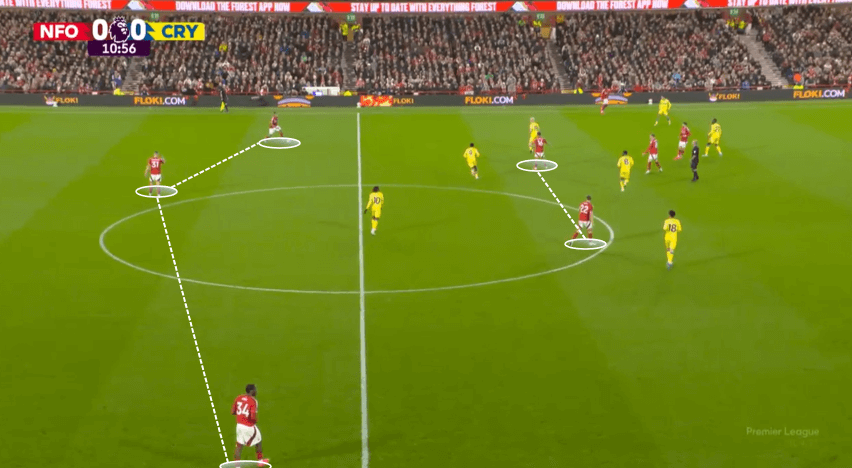
In the first image above, we see Nottingham Forest’s three-back formation, with the double pivot positioned just behind Crystal Palace‘s initial defensive line.
This setup aims to expand the width of the pitch and disrupt the opponent’s structure.
The two pivots play centrally and close together, allowing them to exploit gaps effectively.
This strategic positioning is crucial for penetrating tight defensive setups and creating opportunities from the midfield.
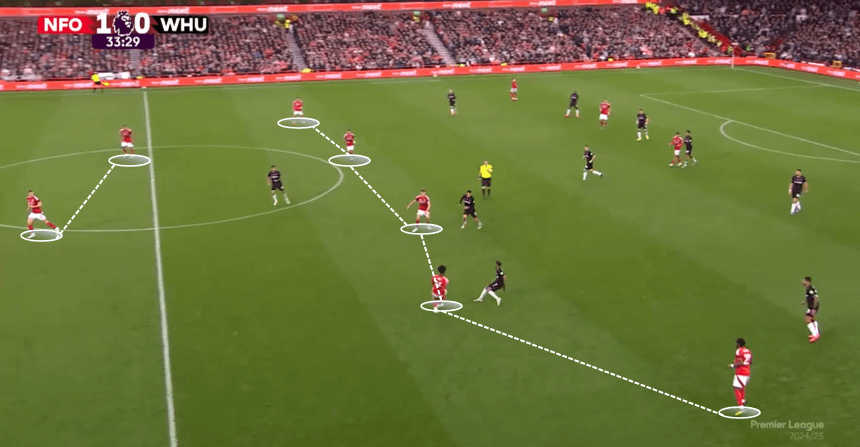
In the second image above, you can see Nottingham Forest’s two-centre-back tactic in action, with the five players spread across the width of the pitch.
This setup shows Forest’s players overloading the centre of the field compared to the West Ham players, creating a four-on-three advantage in midfield.
Once the ball is played into this space, Forest players can turn into an open area due to their numerical superiority.
This allows them to control the game and initiate attacks through the congested central areas.
Nottingham Forest Out-Of-Possession Tactics
Forest typically uses a classic 3-4-3 formation when defending under Nuno Espírito Santo’s coaching style.
However, when defending closer to their penalty box, they transition into a classic 4-4-2 setup.
The 4-4-2 setup effectively congestes the area around the penalty box and reduces the space available for the opponents.
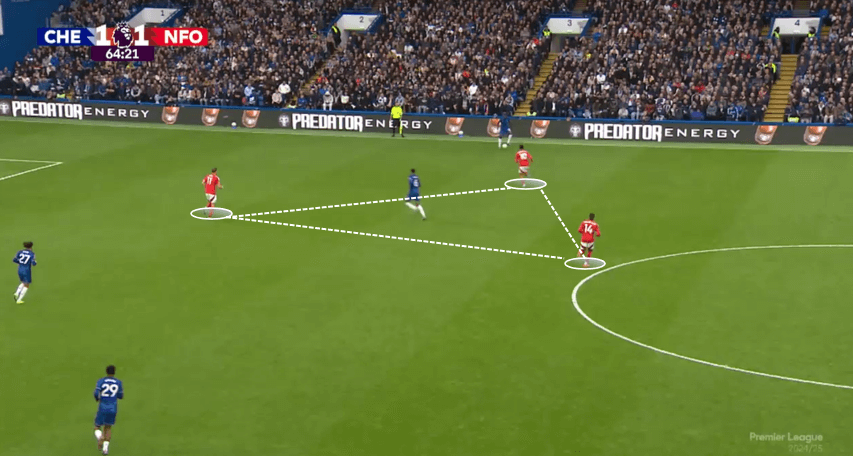
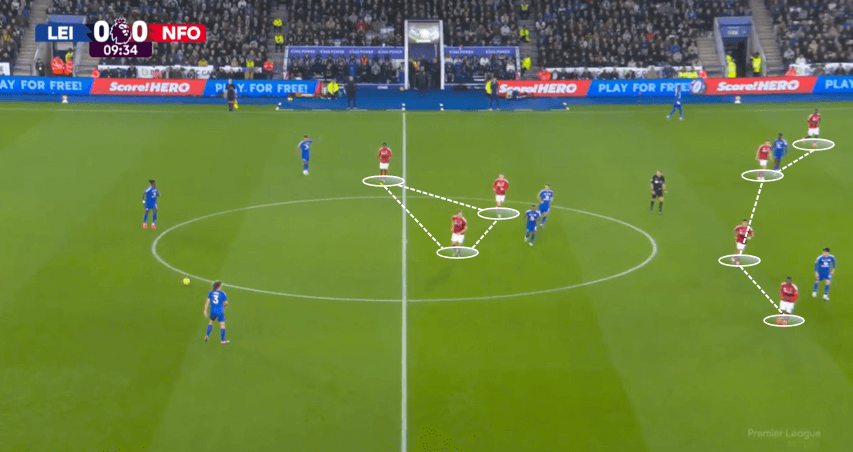
The two images above show Nottingham Forest’s 3-4-3 formation, which mainly focuses on the positioning of the attacking players.
Under Nuno’s strategy, these attackers are arranged in a triangular shape.
This setup aims to move the players collectively, trapping opposing midfielders and preventing them from accessing the ball while staying close enough to disrupt passing lanes.
This triangular formation among the front three in defence is a tactic similar to what Arsenal have employed effectively for some time.
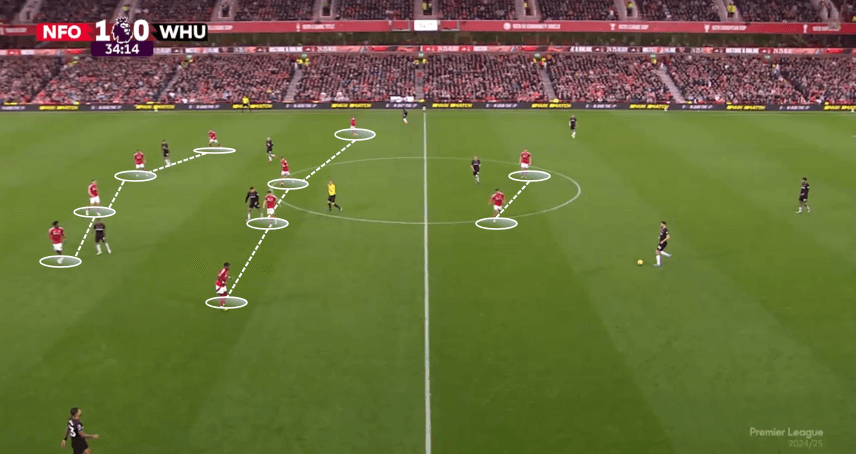
When Forest’s press in the opponent’s final third is bypassed, they typically revert to their 4-4-2.
This setup aims to close gaps centrally and maintain a solid defensive structure.
The 3-4-3 formation is less favoured when defending close to their own box because it can leave half-space gaps open, which opponents could exploit.
In the opponent’s half, Forest uses a triangle-shaped front three, which was shown earlier, to disrupt the opposition’s midfield access.
Once the ball is played past this pressing trio, Forest quickly drops back into the classic 4-4-2.
Nottingham Forest Defensive Tactics
One key factor in Nottingham Forest’s success this season has been their defence, which has significantly limited the number of goals conceded.
Their defensive strength allows them to capitalise on their offensive plays and hold on to secure three points, a vital improvement from previous seasons where they were prone to conceding goals due to minor errors.
They have shown significant progress in closing out matches with a lead.
A crucial tactic that has contributed to shutting down opponents’ attacks is their strategic instructions to defend wide zones aggressively.
Forest prefers to press with high intensity and pace on the flanks, reducing opponents’ time on the ball and ultimately regaining possession more effectively.
This approach not only limits the opponent’s ability to create from wide areas but also transitions the play quickly from defence to attack, which Nuno loves his teams to do.
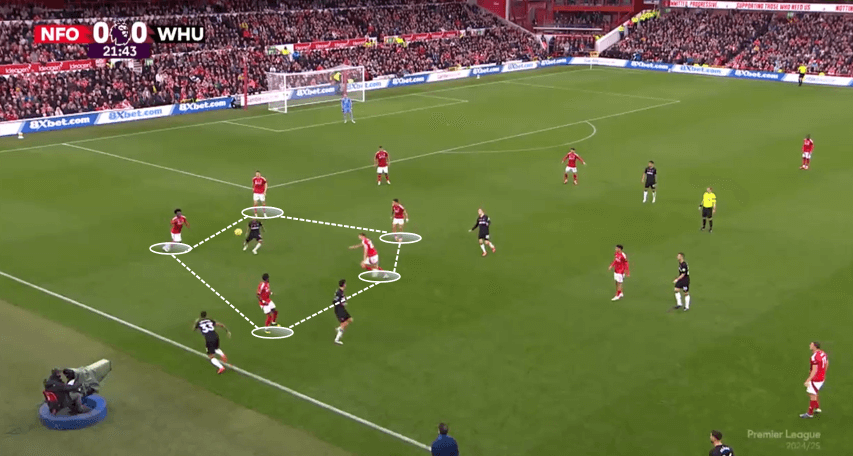
The first image above shows how congested Nottingham Forest likes to keep the opponents in the wide zones.
You can see five Forest players surrounding three opponent players, with two Forest players looking to run at the West Ham player with the ball to regain possession and start a counterattack forward quickly.
Their numerical superiority in wide zones and zonal marking congest opponents has been key to regaining possession and their defensive superiority.
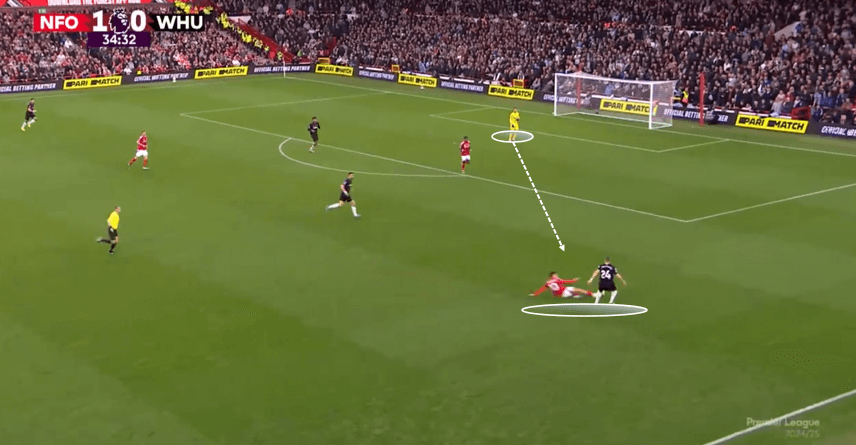
The image above shows another example of how aggressive Forest players are in their press: a player is making a slide tackle in the opponent’s final third.
This demonstrates the aggressiveness that Forest players possess, similar to how Liverpool played under Klopp a few years ago—relentless, with high stamina, fitness, and pressing.
Nottingham Forest High Regains Chart
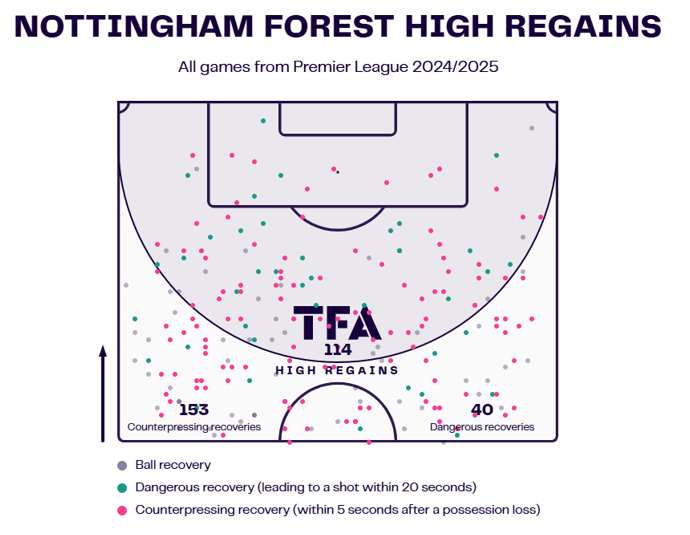
The high regains map above shows just how well Forest recovers the ball in the opponent’s final third.
With 114 high regains and 153 counter-pressing recoveries, their aggressiveness is vital in offsetting opponents who want to try and control the tempo.
This has been key to their defensive brilliance this season so far.
Nottingham Forest Attacking Statistics
In terms of attacking statistics, Forest are very dominant in using their wide players to penetrate the penalty box, which is what Nuno loves.
The use of his full-backs in that 3-4-3 formation allows them to get the counters going and penetrate forward.
Nottingham Forest Penetrating Carries Chart
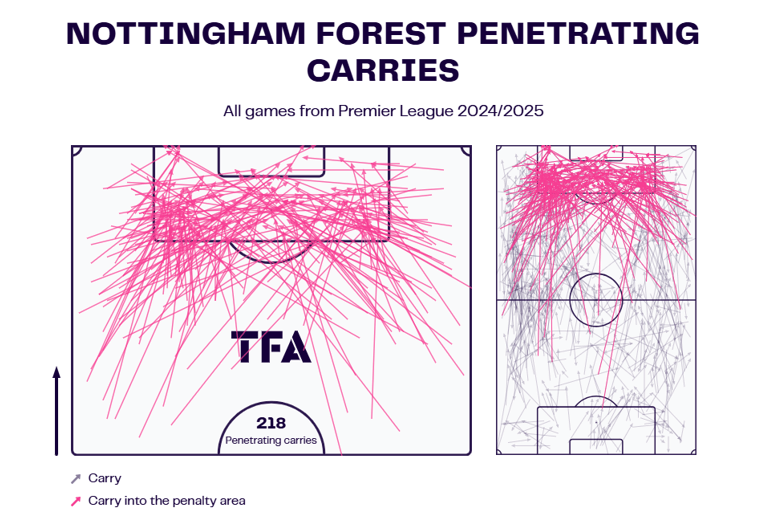
The ball progression map above shows just how much they like to penetrate the opponent’s penalty box from the corners, with many runs from the wide zones, rather than players looking to break into the box centrally, which you tend to see with other teams.
As the penetration map shows, their ability to move forward and create more chances has significantly improved this year.
Nottingham Forest Ball Progression Chart
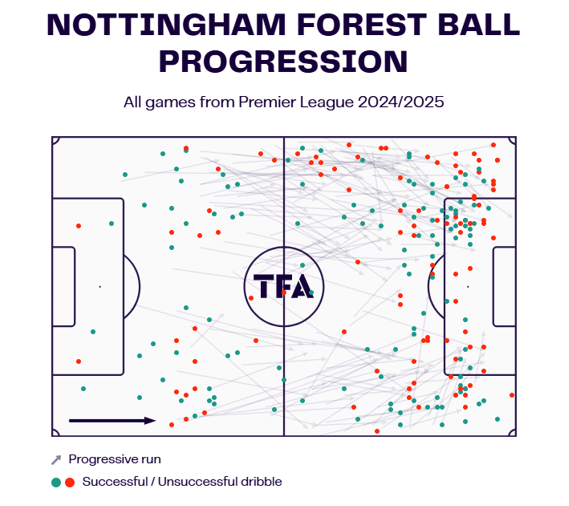
The penetrating carries map above shows not only how they like to enter the box from wide areas, which was also shown by the ball progression map, but it also shows 218 penetrating carries in just 10 league games so far.
For context, they had 273 penetrating carries in the entire 2023/2024 season.
This means they have almost the same number of penetrating carries in only 10 games this year as they did in 38 games last year, showing just how much they have improved in their attacking play with this 3-4-3 formation.
Conclusion
Nottingham Forest have had a great start to the season, with Nuno fully implementing his tactics and philosophy with the team.
This philosophy is centred around high pressing, especially in the wide zones of the pitch, to choke out opponents.
Their 3-4-3 formation, with the fullbacks being key in starting transitions from defence to attack.
They are currently sitting in 3rd place, with only Manchester City and Liverpool ahead of them so far, surprising the English league.
If they can keep this form up, they can definitely look to play in some European competitions next year.
Although it’s unlikely they will stay in the top four for Champions League football, they can fight for the top six and try to get that Europa League football as a first step.
But time will tell, and currently, it’s looking promising.





Comments